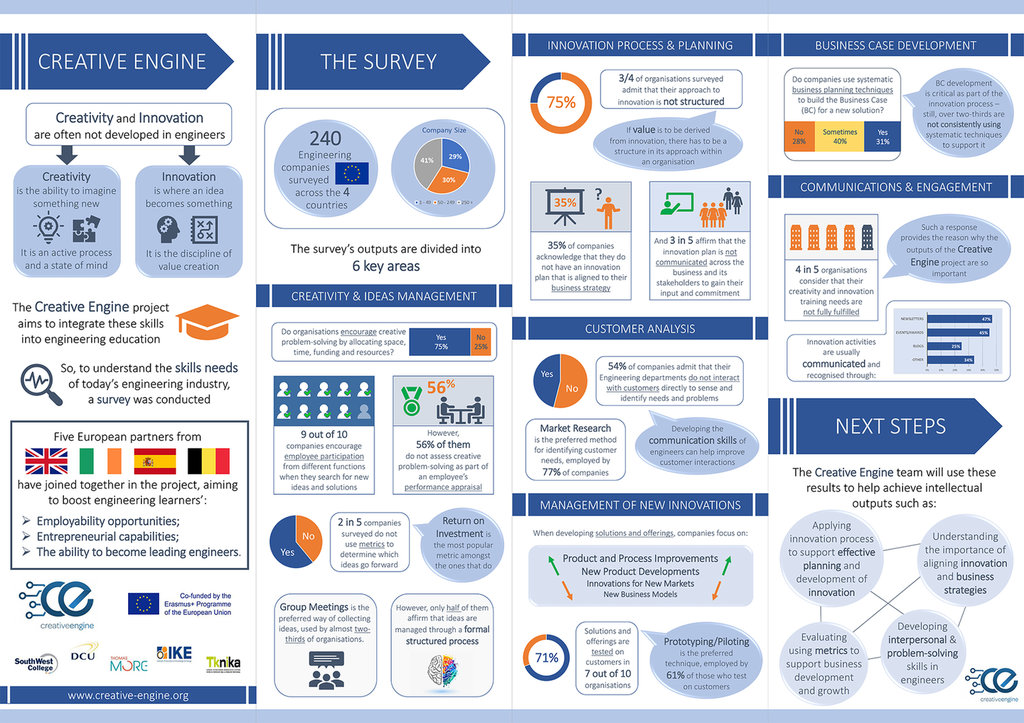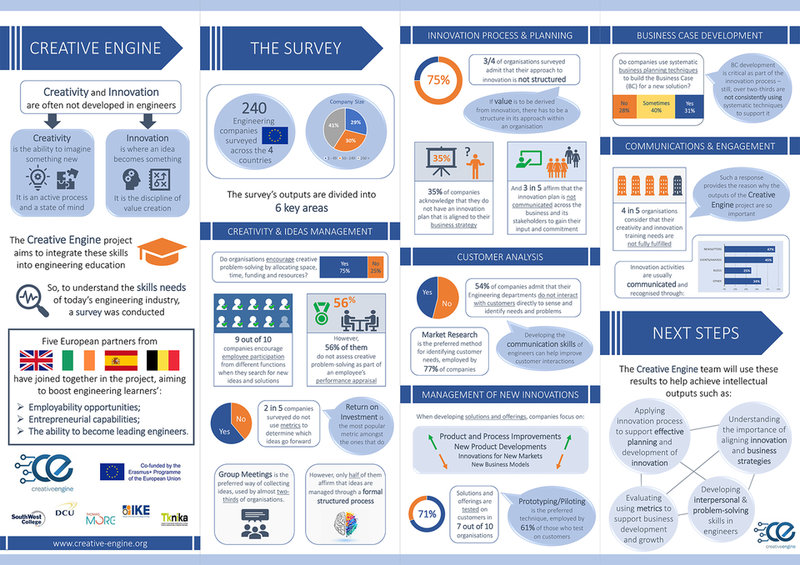Foreword Professor Sa'ad Medhat
There's still room for improvement in innovation
It’s an uncomfortable fact that despite companies stating they need innovation-ready engineering graduates, very few institutions are able to deliver on this requirement. When it comes to the innovation competency of engineering graduates one can clearly hear the ring of the old school report’s final mantra: ‘There’s still room for improvement!’
The EU-funded Erasmus project Creative Engine, in which IKE Institute is one of five partners, will seek to upskill and educate engineers through the development of innovation education and learning resources contextualised for the engineering community, so that the aforementioned mantra is drowned out by a chorus of innovative successes.
The IKE Institute undertook a research study to examine how organised, developed and supported innovation was within engineering-related business across different economic sectors.
Earlier this year, as part of the Creative Engine, the IKE Institute undertook a research study to examine how organised, developed and supported innovation was within engineering-related business across different economic sectors.
The study included the four countries of Belgium, Ireland, Spain and the UK, and attracted the participation of over 240 companies covering all different sizes of businesses, from the small (29%) and medium (30%) to large multinationals (41%). A combination of online surveys and interviews focused on six key areas: creativity and ideas management, innovation process and planning, customer analysis, management of new innovations, business development, and communications and engagement.
Some of the key highlights from the study showed that:
85%
of respondents admitted they didn’t have a structured approach to innovation
37%
acknowledged they didn’t have an innovation plan aligned to their business strategy
3 in 5
said their innovation plan wasn’t communicated across the business nor stakeholders, to gain input and commitment
Business case development
...was seen as critical in the innovation process, although over two thirds of companies weren’t using systematic techniques consistently to support it (25% didn’t use it at all, 43% used it sometimes and only 32% applied it regularly)
It was interesting to see that despite different economic and industrial structures within the four countries participating, the pattern of these above highlights was relatively consistent across all four countries.
The study showed a lack of understanding in engineering-related companies of the value in developing and thus, appraising creative problem-solving (CPS) skills as part of employee performance. Some 56% claimed CPS wasn’t assessed within people performance, however 44% confirmed they did. Given that creative problem-solving is intrinsically linked to engineering capability failure to assess such a skill demonstrates a lack of understanding of where the true value is.
Understanding customer needs and interaction
Data shapes innovative activities and successful innovators know how to make that data speak. Competitive intelligence tells innovators what they need to know about where and how to play.
Some 74% confirmed that they used different methods to identify customer and market needs. From the various techniques put forth in the survey, market research garnered the most popular vote with 42%, followed by scenario planning (23%) and PESTLE (22%).
Proficiency in the use of data analytics tools and techniques such as R, SAS, Apache Spark, Python, Excel and RapidMiner and platforms such as Google Analytics, Facebook Analytics, Tableau, IBM’s Cognos, Looker, SAS, and Microsoft’s Power BI was seen by engineering companies surveyed as a prerequisite skill, and business analytics was synonymous with their innovation drive.
Engineers interacting directly with customers presents a certain fear within the hearts of sales teams. Concerns include “they’ll over-spec the requirement and take the customer down the wrong path”, or worse still, “the customer will become better informed and start asking awkward questions before signing”.
It was therefore refreshing to learn from the survey that 46% of companies had facilitated engagement of their customers with their engineering departments. Even so, the ‘stalling before the deal goes through’ mindset still has a strong presence in sales against engineering and is the reason why 39% allowed interactions ‘in-part’ and 15% didn’t enable their engineering departments to interact directly with their customers at all.
Mapping the innovation ecosystem
Much emphasis was placed on incremental innovation with 43% giving focus to product and process improvement as being ‘somewhat of a priority’. A little over a third claimed innovation to deliver new product developments was ‘somewhat a priority’. Sadly, innovation to create new business models didn’t secure much of a priority, with only 22% claiming it as a high priority.
Innovation to develop into new markets was seen as a priority with 45% stating this focus. This innovation drive is linked directly to increasing sales revenue through new market expansion to meet business growth objectives.
Although this is good to see, as it shows correlation between business direction and innovation intent, the fact that the survey results uncovered there was limited consideration being given to the application of innovation ecosystem mapping (critical in new market developments) suggests that many businesses are losing out on the opportunity to discover new and valuable uncontested blue ocean markets.
A good mapping technique is to first identify what is the priority of focus and extend outward taking in primary actors, stakeholders, influencers and touch points where new innovations could happen.
Innovation ecosystem mapping isn’t an easy activity to undertake, but it is essential to identify the players, dependents and those vital connections that could make or break new market developments. The centre of the ecosystem map can be a product, a business unit or even an entire business.
A good mapping technique is to first identify what is the priority of focus and extend outward taking in primary actors, stakeholders, influencers and touch points where new innovations could happen. In any innovation ecosystem mapping, growth opportunity profiles (GOPs) should always be sought to improve impact and value.
Talking up innovation
Talking up innovation is key in any organisation that wants to move towards a truly embedded innovation culture. Internal communications and motivational activities (both intrinsic and extrinsic) need to be designed, programmed and implemented.
Keeping innovation projects just within a small innovation unit is not a demonstration of a fully embedded people innovation approach. In fact, if not managed correctly, such a structure can be to the detriment of the business really embracing innovation, as it produces an elitist attitude that innovation is only in the domain of the very few.
Innovation needs to be seen as something that everyone has the capability to do and it is something to be valued by all. Recognising innovation activities in a balanced and motivationally engendering way is a prerequisite of innovation culture development.
Innovation needs to be seen as something that everyone has the capability to do and it is something to be valued by all.
A third of survey participants indicated that innovation activities were being recognised in their internal newsletters (online and print), and the same proportion identified good participation levels through innovation events and awards. As a motivational communication tool to improve innovation take up, blogs (with 16% of respondents) was cited, with a further 23% suggesting other methods. Out of the 23% over half of these respondents used social media in innovation communications and promotions.
Innovation is a powerful means of creating a future a business wants. This statement was supported and agreed upon by 67% of all small businesses and echoed by 48% of all medium sized business and 48% of all large companies.
Of course, these responses show that, large or small, some businesses from the survey have recognised the inherent power of innovation, but many more, particularly those in the medium and large-scale businesses, have a journey still to make when it comes to the take-up, pace and maturity of their innovation capabilities.
Through the educational outputs of the Creative Engine project, it is hoped that this journey will a much smoother and rewarding one for the engineering business community.


